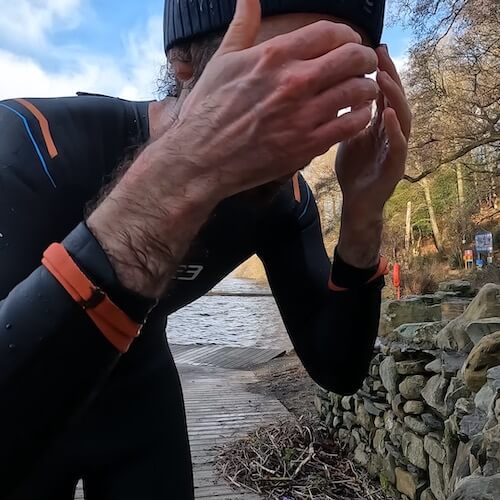
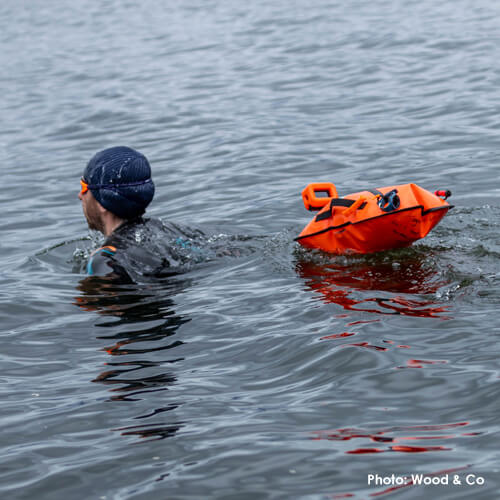
While excited by the promise of daylight stretching back out, winter is still here, and the water temperatures continue to drop. This requires extra thought, adaptation, and energy. The extra kit. The extra faff. The demands of drying your equipment at home. The additional consideration for interviews, navigating the bitter air and water temperatures alongside wind, rain, snow, and ice. There have been times on the shoreline so cold that I have struggled to retie my shoelaces and fasten the zip of my coat. Times where I have dropped my hot brew, as my hands have turned into shaky numb claws. Moments where I have even had to peel my frozen swim gloves off the concrete.
Arguably this is part and parcel of living in the North of England. Plus, I am also not the only swimmer choosing to continue their practice through winter. As one interviewee put it, there are still ‘busloads’ of cold-water enthusiasts turning up to Rayrigg Meadow and Millerground, blissfully ignoring England’s questionable ‘official’ bathing season (May-September) [1].
Some of these swims have turned into charitable endeavours. Alongside the usual meetups, sharing tea, cake, and shivery selfies, January saw many individual and collective daily dip challenges, including raising money for Crisis UK, Mind, and Surfers Against Sewage.
I also unexpectedly found myself in the middle of a busy charitable gathering televised by BBC North West as I was getting dry, post-swim. It was quite the spectacle. One that was difficult to reflect on at the time with the heightened sense of cameras, budgie smugglers, exposed skin, wet socks, and a whole lot of whooping and cheering.
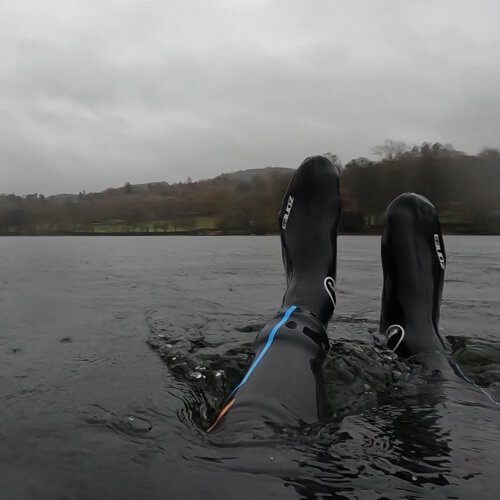
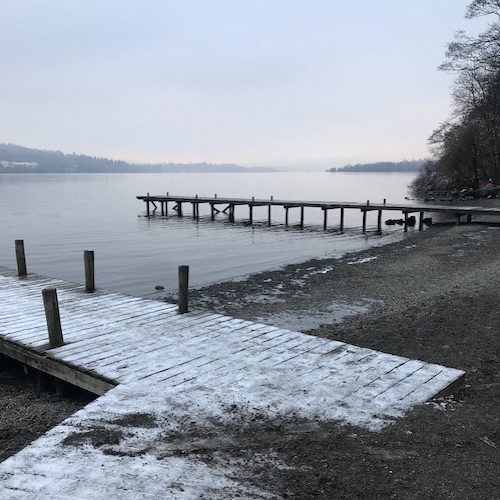
Notably, some users at these designated public bathing sites do not enter the water, including anglers, walkers, locals, day visitors, and curious spectators, whilst some will be seen keeping their toes above the water with paddleboards, kayaks, and canoes. You will also see sailboats, hire boats, and ferry passengers on the Windermere cruiser.
Of course, these activities in and out of the water are not exclusively shared by humans. There are freshwater fish, critters, and plants featuring below the surface. Also, a variety of birdlife can be encountered during winter at Windermere, particularly at the crack of dawn, including common species such as Canada geese, grey herons, great-crested grebes, mallards, ‘mute’ swans, gulls, and confident robins.
Plus, the interviews are often paused by the greeting of wet dogs, some who choose to pinch and play with some of the swimmer’s loose socks whilst unguarded on the shore. I tried not to laugh.
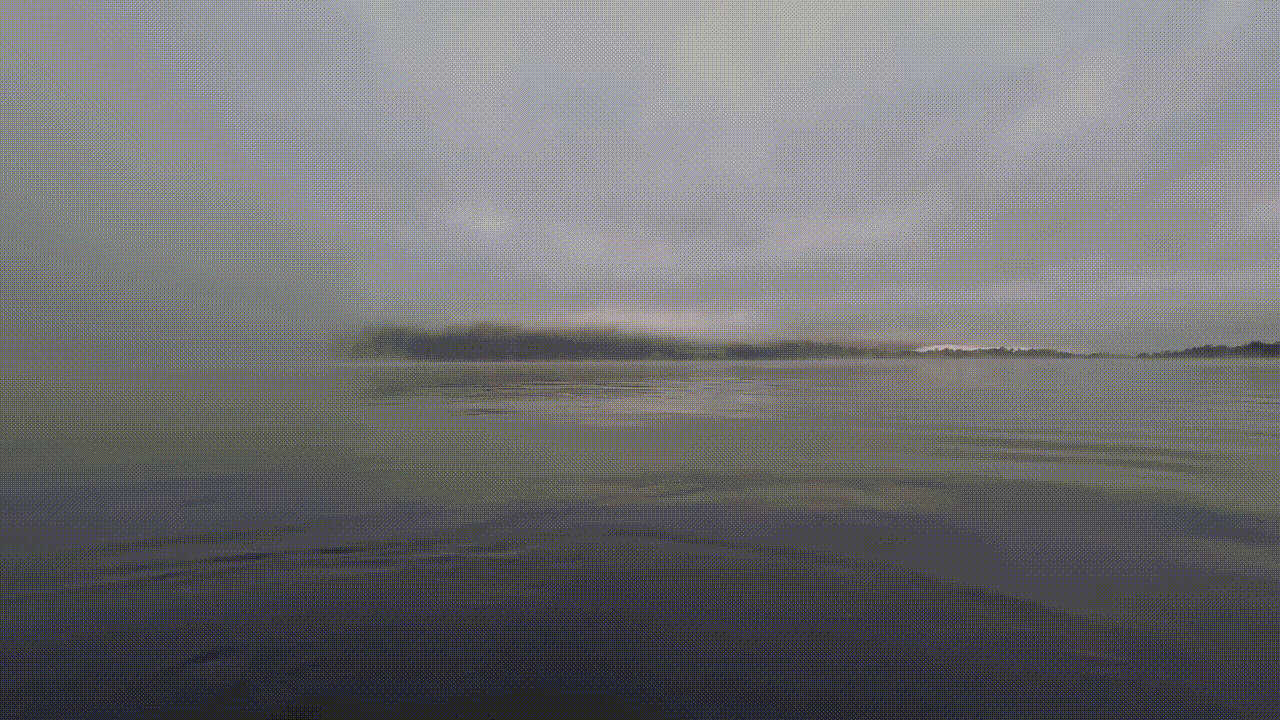
Jokes aside, cold-water swimming can be risky, so it is vital to raise awareness as its practice gains more appeal. While some will question how much swimming occurs during the winter, there are still a rare few, head down, armed in neoprene, tow floats dragging behind, shooting between the buoys and back, or occasionally between the two jetties.
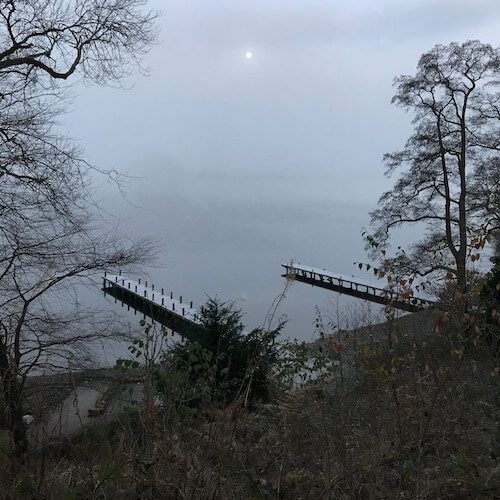
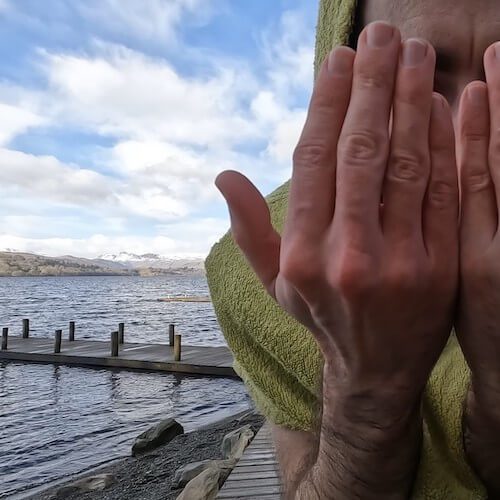
There will also be those hoping to ‘push’ a distance or a time, which can be extra risky. Cold-water shock, hypothermia, and after-drop are to be taken seriously, plus there can be other bodily stresses and differences that complicate our responses in cold water [2].
For example, if my body is short of sleep, food, and hydration, I know that my swim will be unsettled. I am also never fully confident about how my body will respond, so I slowly stagger into the water, taking note of my breath. And then, when my body tells me it is time to exit, I try to get dry and warm as quickly as possible, swapping my swimwear with a towel robe, woolly layers, two coats, and my trusty beanie.
The Outdoor Swimming Society [3] and Outdoor Swimmer magazine [4] have shared several guidelines for swimmers during the winter. I also support those trying to change the narrative of pushing the limits, including those of regular Windermere swimmers [5][6]. No two swims are the same. So, please keep listening to your bodies, take extra safety measures, and do try and look out for each other.
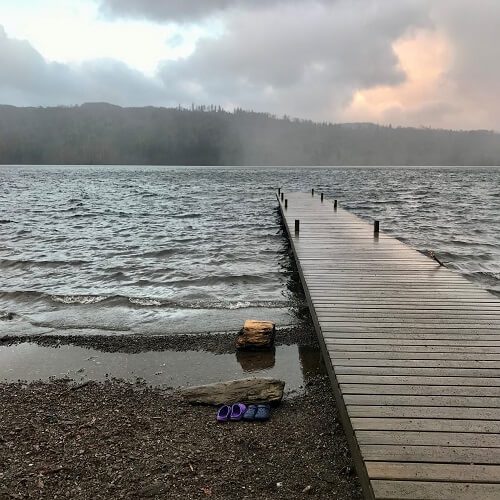
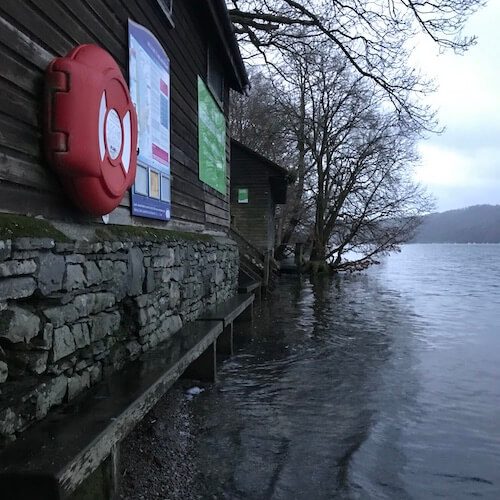
During my observations, most swims have understandably turned into quick dips, often supported. Recreational swimming groups still gather multiple times a week, showing steady numbers, Sunday mornings often being the busiest.
Winter brings many difficulties for people in many forms, but these community meetups can often feel like a positive routine for those accustomed. Sometimes an opportunity to sport the latest swim accessory or fleecy-robed comfort. But also a chance to share a whinge, a giggle, a brew, a moment to pause and ponder. Some even suggest it has become a lifeline.
It can be tricky mingling with any community as a researcher, especially given my work critically explores open-water swimming and environmental health. A grey area that this project continues to question, noting the complex tensions of Windermere’s water quality pressures, conflicting user groups, conservation efforts, and increasing public attention [7], alongside uncritical, romanticised, and often inequitable notions towards ‘healthy’ water-based leisure [8][9][10].
Still, while those tensions co-exist, I feel touched by the generosity of many regular community members towards my research. I have received oodles of kindness, time, and reflection, offering enthusiasm during the swim-along interviews, lifts back to Kendal, sharing the project, and even coming to my rescue at short notice when my GoPro battery decided to go bust.
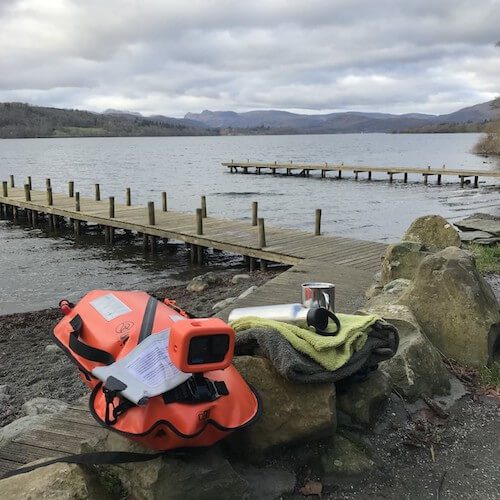
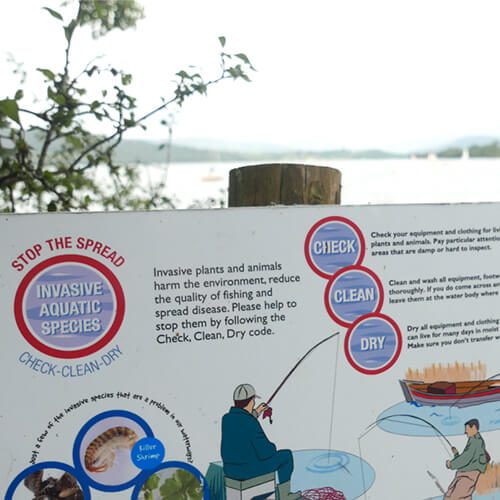
Of course, inclusivity within swimming (indoor and outdoor) has a long way to go, and I am confident that welcomeness has not felt evenly shared at times, including at Windermere. After all, it can take considerably more than a cozzie and a towel to feel comfortable in these spaces. Even the most subtle slight can make an impact.
Arguably, swimming will never be universally accessible to every need and challenge. Nevertheless, while I cannot speak for every group or user, I have observed many members of the swimming communities at Windermere trying to promote inclusivity beyond its commercially marketable appeal, actively trying to make their dips, dunks, and swims more open. A motivation encouraged by this project as it seeks more ways to be care-full within our swimming practices all year round.
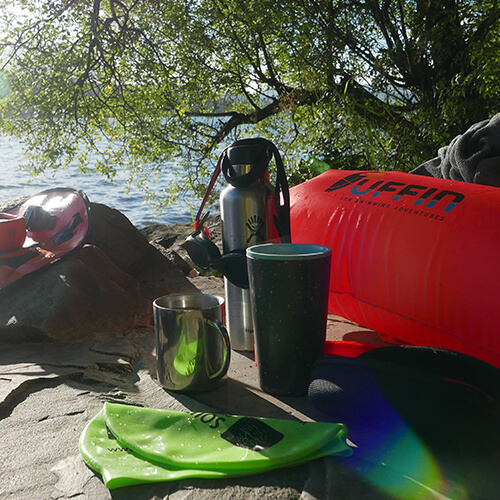
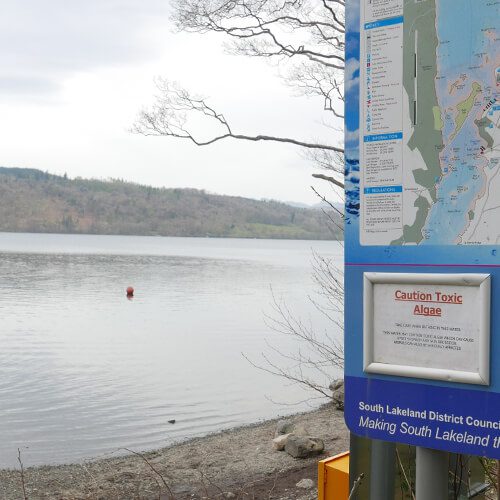
Part of that care includes giving voice to the different bodily, social, political, and environmental factors shaping ‘healthy’ experiences of open-water swimming at Windermere. Fortunately, I have not been short of people to speak to over these past six months, and I cannot envisage these conversations with different people drying up before September.
So far, I have talked with dippers, swimmers, coaches, swim communities, conservation groups, activists, influencers, academics, you name it. So many insightful voices have come forward, sharing their motivations and experiences alongside the many tensions impacting their swims at Windermere. Yet, I am still looking to schedule more interviews on the shorelines and in the water.
So, if you fancy it, why not get in touch.
In the meantime, keep listening to your bodies and remember to keep an eye on folk, particularly those entering the water alone. Winter will eventually phase out, and the air will begin to warm, but the cold water will not be shifting for some time. Take care.
References
[1] Environment Agency. (2022). Swimfo: Find a bathing water. [online]. Department for Environment, Food & Rural Affairs (DEFRA). Available at: <environment.data.gov.uk/bwq/profiles> [Accessed: 8 Feb 2023].
[2] Tipton, M., Massey, H., Mayhew, A. and Morgan, P. (2022). Cold water therapies: Minimising risks. British Journal of Sports Medicine, 56(23): 1332-1334.
[3] Outdoor Swimming Society (Multiple Authors). (2023). Cold (Articles). [online]. Outdoor Swimming Society. Available at: <www.outdoorswimmingsociety.com/category/survive/cold> [Accessed: 8 Feb 2023].
[4] Outdoor Swimmer (Multiple Authors). (2023). Cold Water Swimming (Articles). [online]. Outdoor Swimmer Magazine. Available at: <www.outdoorswimmer.com/category/featured/cold-water-swimming> [Accessed: 8 Feb 2023].
[5] McCarthur, G., Mccreadie, V. and Gerrish, B. (2022). Cold Water Swimming Safety Tips. [media]. Instagram @ gillymcarthur. (22 Dec). Available at: <www.instagram.com/p/CmCgHX6D0Eh> [Accessed: 8 Feb 2023].
[6] Meek, H. (2022). Winter Swimming – Let’s change the Narrative. [media]. Instagram @south_lakes_swimming (17 Oct). Available at: <www.instagram.com/p/CjzeOQyKH7U> [Accessed: 8 Feb 2023].
[7] Freshwater Biological Association. (2022). The State of Windermere, InfoNote 1. [online] Freshwater Biological Association (1 Feb). Available at: <www.fba.org.uk/fba-voice/the-state-of-windermere-information-note> [Accessed: 8 Feb 2023].
[8] Bell, S., Leyshon, C., Foley, R. and Kearns, R. (2018). The “healthy dose” of nature: A cautionary tale. Geography Compass, 13(1): p.e12415.
[9] Atkinson, S. (2019). Wellbeing and the Wild, Blue 21st-Century Citizen, In: Foley, R., Kearns, R., Kistemann, T. and Wheeler, B. eds. Blue Space, Health and Wellbeing: Hydrophilia Unbounded. Abingdon: Taylor & Francis: 190-204.
[10] Olive, R. (2022). Swimming and surfing in Ocean Ecologies: Encounter and vulnerability in nature-based sport and physical activity. Leisure Studies: 1-14.
Author: Taylor Butler-Eldridge | Published: 8 February 2023
Blog
Keep up to date with the blog posts and updates from the research project.
